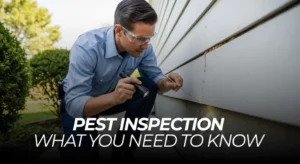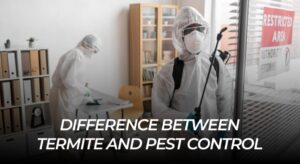Termites have always been an issue of concern to homeowners, more so in some of the states that experience good climatic conditions, such as Florida. However, things have now developed alarmingly. The researchers have discovered new termite crossbreeds that would be a big problem for homes and buildings.
This evolution poses more concerns about how homeowners can remain safe in their possessions and the future of pest control.
We will explain the new termite hybrids in Florida: what this means for homeowners. Understanding the problem, possible solutions, and what every homeowner should know, hence, here is what homeowners need to know.
What Are Termite Hybrids?
Termite hybrid is the intercourse of two termite species, and a population with distinct behaviors or characteristics ensues. These hybrids are especially harmful, as they inherit the characteristics of both parents, and, in most cases, they are much stronger and violent.
The Florida termite hybrids are a product of a hybrid between the Asian subterranean termites and the Formosan termites. They are two of the most troublesome termite species in the world, and their children are made up of the worst of two worlds.
Researchers have noted that these hybrids are found to be growing at a greater rate, eating wood at a high rate, and having bigger colonies than the parent species.
Why Florida Is the Perfect Breeding Ground for Termites
The warm and humid climate of Florida is the most suitable environment for termite growth. The state is swarming with termites: it has cities and towns along the coast, wood frame buildings, lots of them. Residences are the most susceptible as the warm winters in Florida permit termites to keep active all through the year.
Urban sprawl and the transfer of wood materials within and across the state have contributed to the rise of hybrid termites. These conditions present a plentiful amount of food to the termites and allow the populations to thrive, making the issue worse.
The pest control methodologies that homeowners have been using are suddenly obsolete, and there is a desperate need to implement new ones.
What Makes Termite Hybrids Dangerous?
Many behaviors and characteristics explain why the hybrid termites are a major concern:
- Aggressive Wood Consumption: Hybrids have the capability of feeding on the wood more rapidly than other species of termites, causing damage to structural properties faster.
- Larger Colonies: The colonies that are hybrid tend to be larger and increase the destruction rate.
- Resilience: Hybrids resist conventional methods of termite elimination, even some of the chemical-based elimination methods.
- Extended Range: These termites are expanding in Florida at a fast rate, and they are occupying new grounds where termites were not so prevalent before.
They are strong and fast-growing, which makes them a problem for a pest control expert and a house owner, and even for scientists trying to understand their biology. The best solution is prevention and suspicion to reduce their effects.
Steps Homeowners Can Take to Protect Their Properties From New Termite Hybrids
There is no option for saving your property against the hybrid termites without acting proactively. There is a way to minimize the danger and keep your home free of termites:
Inspect Regularly
Become regular with the scheduled inspections with authorized services of pest control. Infestations can be detected during regular inspections before they get out of hand.
Control Moisture Sources
Termites require moisture to live. Seek to fix leaky taps, ensure your roof is not damaged, and has proper ventilation of the home to curb humidity.
Treat Wood-soil contact
Avoid direct contact with wood and soil by putting down concrete barriers, or even make use of treated wood in the construction of your house.
Seal Entry Points
Seal all the hollows, cracks, and crannies in your walls or foundation to inhibit access points for the termites.
Clearing Wood and Debris
Also, store firewood and lumber, as well as other wood materials, far away from the foundation of your home, since this is a termite attractor.
These actions would dramatically decrease your home-termite susceptibility, thus increasing the difficulty of a hybrid colony proceeding to establish or spread within your residence.
What Experts Are Saying About Termite Hybrids
These hybrid termites have elicited discussion between scientists as well as pest control personnel seriously. It is assumed that the ancestors of pest control mechanisms will have to change rapidly to be able to respond to this new threat level.
According to the top-notch entomologist, Hybrid termites would multiply to other parts of the warm states beyond the state of Florida unless curbed.
Important challenges, they state, are the need to introduce the new treatment methods and new termite baits as these hybrids demand newer techniques of treatment. The pest control companies, too, have now started encouraging home owners to spend on the preventive rather than act after the infestation has taken place.
The Future of Pest Control in the Face of Hybrid Termites
Pest control strategies are also changing with scientists and businesses engaging to fight hybrid termites. New inventions like monitoring devices with AI and environmentally friendly termite treatment are becoming popular. Future approaches may entail coming up with specific pesticides or biological alternatives that interfere with the reproduction of termites.
Awareness and prevention are the steps that are most effective today. It is critical to maintain communication between homeowners and pest control professionals. Being aware and acting at the appropriate time can help you protect your home.
Conclusion
Hybrid termites in the state of Florida are something of an eye-opener to the state homeowners. They are also quicker, more devastating. It is harder to get rid of when compared to other species of pests, and the best practice is prevention.
As a Florida resident, it would be a good idea to book an inspection with professional pest control services today. Protecting yourself against the growing menace of hybrid termites should involve early detection and prevention.







